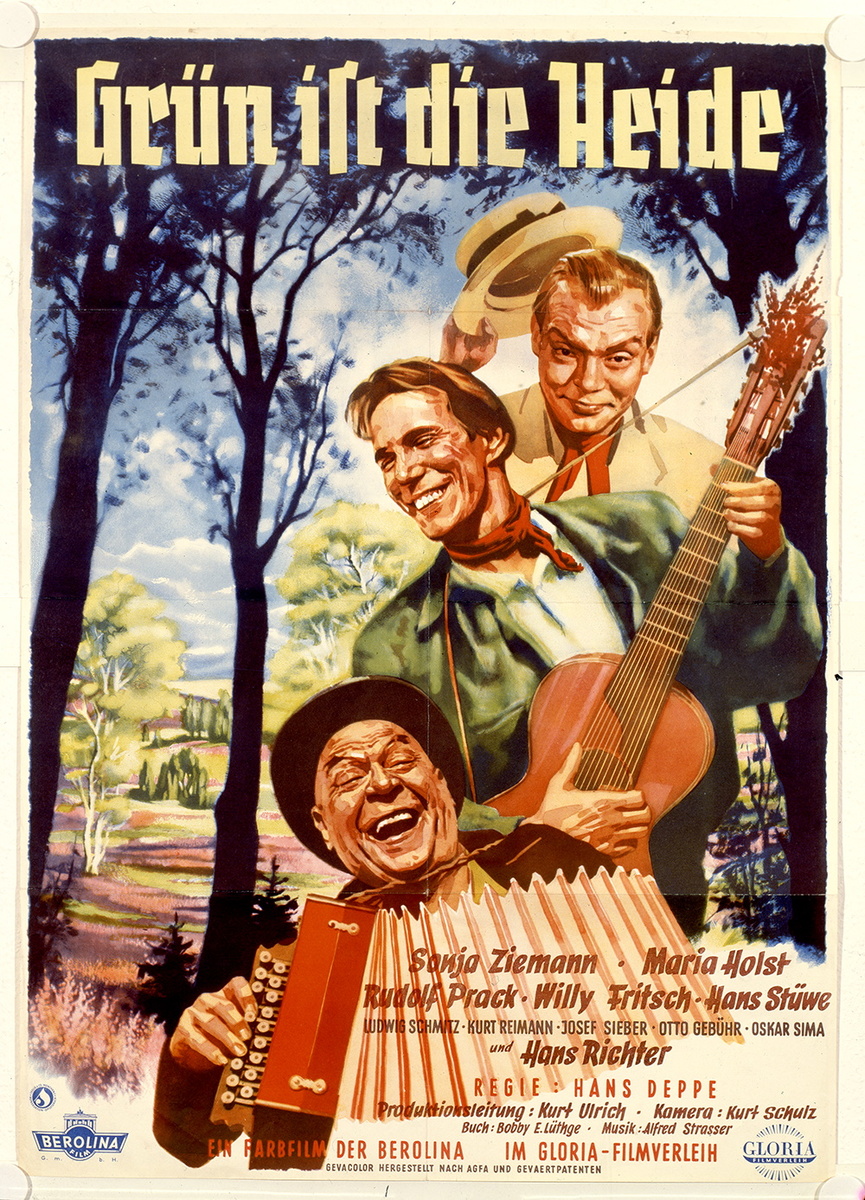Music: Grün ist die Heide (1951)
Abstract
Along with nature and gender, music serves as the third major reference system in Grün ist die Heide [Green is the Heath]. This 1951 film poster features three minor but important characters: a trio of Lüneburg yokels whose music provides much of the film’s soundtrack. They are (from top to bottom): Hannes (played by Hans Richter), Nachtigall (played by Kurt Reimann), and Tünnes (played by Ludwig Schmitz). In one critical scene near the end of the film [1:10-1:14], Nachtigall sings “The Song of the Riesengebirge” at a town folk festival [Schützenfest]. He does so at the request of the local judge [Amtsrichter], who dedicates the song to the Sudenten Germans living among them. The judge describes the song as “something from the homeland” [“etwas aus der Heimat”]. As a song about “Giant German mountains,” it forges a strong link between nature, music, and folk traditions. The song lyrics are included underneath the film poster.
Source
Lyrics, “Song of the
Riesengebirge” Blue mountains, green dale, Oh, my dear Riesengebirge, I’ve had my ups and downs, Oh, you, my dear Riesengebirge, [ . . . ] Source: Riesengebirglers Heimatlied, Lyrics: Othmar Fiebiger (1914),
in Heimatlieder der Sudetendeutschen,
edited by Walli Richter. Munich: Verlagshaus Sudetenland, 1994. Song
translated for the Intersections project by Deborah Cohen.
(verses 1 and 2, with refrain)
And in their midst, a small
homestead,
A glorious patch at the end of a trail,
This is
where I was born and bred.
When first I left for this new
land,
The mountains regarded me wistfully.
As a child, as a
young man,
I knew not what would become of me.
Where the Elbe so furtively
snails,
Where to this day the Rübezahl and his dwarves
Still
spin legends and fairy tales.
Giant Mountains, German
mountains,
My sweet homeland dear!
I have laughed and sung
merrily.
And yet in some anxious hours,
My heart has throbbed
silently.
And after many a year, a yearning so pure
Drew me
back to the house of my birth.
So homesick was I that I could not
endure
Another moment on foreign earth.
Where the Elbe so furtively
snails,
Where to this day the Rübezahl and his dwarves
Still
spin legends and fairy tales.
Giant Mountains, German
mountains,
My sweet homeland dear!
Source: Film poster von Grün ist die Heide (1951). Deutsches Filminstitut, Frankfurt am Main.
Further Reading
Michaela S. Ast, “Flucht und Vertreibung im bundesdeutschen Spielfilm
der 1950er-Jahre,”
Bundeszentrale für politische Bildung,
https://www.bpb.de/geschichte/zeitgeschichte/deutschlandarchiv/74912/flucht-und-vertreibung
(last accessed: June 26, 2021)
Alon Confino, “‘This Lovely Country You Will Never Forget.’ Kriegserinnerungen und Heimatkonzepte in der westdeutschen Nachkriegszeit,” in Das Erbe der Provinz. Heimatkultur und Geschichtspolitik nach 1945, edited by Habbo Knoch. Göttingen: Wallstein, 2001, pp. 235–51.
Johannes von Moltke, No Place like Home. Locations of Heimat in German Cinema. Berkeley and Los Angeles: University of California Press, 2005.